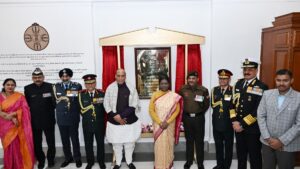Oil and Natural Gas Corporation (ONGC), one of India’s leading energy exploration and production companies, achieved a significant milestone on January 7 by commencing the first oil production from the deep-water KG-DWN 98/2 Block. Located in the Krishna Godavari (KG) basin off the Bay of Bengal on the Kakinada coast, this development marks a crucial step forward in India’s energy landscape.
Key Project Details
The KG-DWN 98/2 Block is situated approximately 25 km from the coastline. The anticipated peak production from the 98/2 field is remarkable, with expectations set at around 45,000 barrels of oil per day and over 10 Million Metric Standard Cubic Metres per Day (MMSCMD) of gas. This achievement reflects the culmination of meticulous planning and the application of cutting-edge technologies.
Boosting Aatmanirbhar Bharat
Minister Hardeep Singh Puri, taking to X, lauded the achievement as a major boost to the Modi government’s “Atmanirbhar Bharat” campaign. He emphasized the project’s contribution to the national energy goal, stating that 45,000 barrels of oil per day and 10 million cubic meters of gas per day are expected to be produced. This development aligns with India’s vision of achieving self-reliance in the energy sector.
Impact on ONGC’s Production
Ratnesh Kumar, Executive Director and Asset Manager (ONGC-Kakinada), emphasized the transformative impact of the 98/2 block on ONGC’s overall production. He stated, “The 98/2 block is likely to help increase ONGC’s total oil production by 11% and natural gas production by 15%.” This uptick in production is a significant boost for ONGC, contributing to India’s self-reliance in meeting its energy needs.
Technological Challenges and Solutions
In 2020, ONGC initiated a comprehensive exercise to kick-start oil production from the 98/2 block. The project faced technical challenges due to the waxy nature of the crude oil. However, ONGC tackled these challenges head-on by adopting innovative Pipe-In-Pipe technology. This approach allowed the efficient extraction of crude oil from the deep-water reservoirs, showcasing ONGC’s commitment to overcoming technical obstacles.
Global Collaboration and ‘Make in India’ Initiative
To meet specific technical requirements, ONGC sourced subsea hardware from abroad. The fabrication work, a crucial aspect of the project, was predominantly carried out at the Modular Fabrication Facility in Kattupalli, Tamil Nadu. This aligns with the ‘Make in India‘ initiative, emphasizing domestic production capabilities and self-sufficiency in the oil and gas sector.
Future Outlook
As the project advances, ONGC is actively working towards the final phase of the 98/2 block, with efforts underway to commence the production of the remaining oil and natural gas by mid-2024. This underscores ONGC’s commitment to sustainable energy development and its pivotal role in shaping the future of India’s energy landscape.
Important Questions Related to Exams
1. What is the primary location of ONGC’s recent oil production milestone?
a) Arabian Sea
b) Bay of Bengal
c) Indian Ocean
2. What technology did ONGC adopt to address technical challenges in extracting crude oil?
a) Fracking
b) Pipe-In-Pipe
c) Hydraulic Pumping
3. Who is the Executive Director and Asset Manager for ONGC-Kakinada?
a) Ratnesh Kumar
b) Deepak Singh
c) Neha Sharma
Kindly share your responses in the comment section.




 Non-Government NPS Subscribers Can Now W...
Non-Government NPS Subscribers Can Now W...
 Param Vir Dirgha at Rashtrapati Bhavan I...
Param Vir Dirgha at Rashtrapati Bhavan I...
 NHAI Introduces India’s First Wildlife-S...
NHAI Introduces India’s First Wildlife-S...







